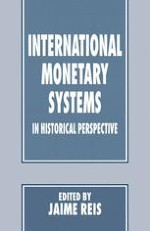1995 | OriginalPaper | Chapter
Portugal and the Bretton Woods International Monetary System
Authors : Michael D. Bordo, Fernando Teixeira dos Santos
Published in: International Monetary Systems in Historical Perspective
Publisher: Palgrave Macmillan UK
Included in: Professional Book Archive
Activate our intelligent search to find suitable subject content or patents.
Select sections of text to find matching patents with Artificial Intelligence. powered by
Select sections of text to find additional relevant content using AI-assisted search. powered by
Portugal adhered to fixed exchange rates for long periods in modern history. The Portuguese currency was pegged to gold from 1854 to 1891. In the twentieth century, the escudo was pegged to sterling from 1931 to 1949 and from 1949 until 1973 the escudo was pegged to the dollar. The monetary authorities exhibited a strong and credible commitment to the maintenance of the fixed rate which is clearly illustrated by the behaviour of the nominal exchange rate throughout the period from 1931 to 1973 (see Figure 8.1). In particular, the escudo-dollar central parity was kept constant from 1949 until 1971, when the dollar was devalued. This commitment is apparent if we compare the behaviour of exchange rates during both wars and immediate post-war years. Thus, the escudo can be considered a hard currency during the 1950s and 1960s, supported by persistent balance of payments surpluses and by large gold and foreign exchange reserves. By the end of the 1960s, the Portuguese monetary gold stock was about 2.25 per cent of the world total monetary stock.
